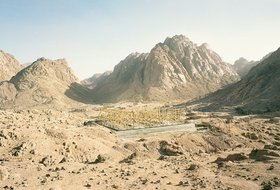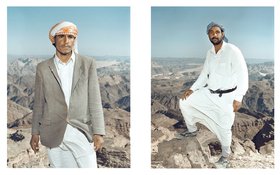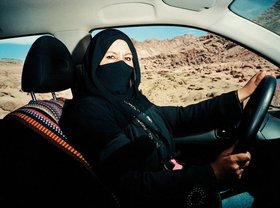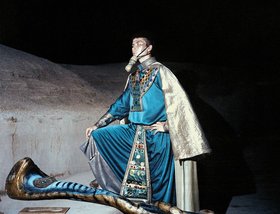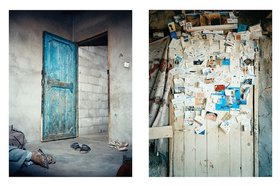Essays
Go Down, Moses: Tourism, Space and Ideology.
Reflections from a book on South Sinai
INTRODUCTION
South Sinai, in Egypt, is a place freighted with history. Long inscribed into the Biblical narrative, it was a locus of conflict in the twentieth century and is now a thriving tourist destination.
Cairo-born photographer Ahmad Hosni's book, Go Down, Moses: A Book on South Sinai, is not a documentary project. While his stated aim is to 'document and comment on a place in the state of becoming a tourist enclave', the project defies some of the basic tenets of the documentary photo-story, featuring a sequence of un-captioned photographs laid out in an album-like manner rather than in a series. Eight newly-commissioned articles by a number of scholars function as extended annotations through which the photos can be contextualized.
The author's cross-disciplinary endeavour casts a critical gaze onto issues including tourism, development and the social landscape in South Sinai. This came to the negative attention of the local authorities there, who decided to block the release of the book just a few weeks before scheduled publication in 2010.
This article is an abridged version of the last essay in the book, entitled Go Down, Moses: A Book on South Sinai.
GO DOWN MOSES: TOURISM, SPACE AND IDEOLOGY. REFLECTIONS FROM A BOOK ON SOUTH SINAI.
Don't seek to know how to look at a landscape –
compose a garden instead. Learn the aesthetic
error of submitting everything to a law: levelling
the local event produces boredom and ugliness,
a world without landscapes, books without
pages, deserts. Take everything away and you
will not see. To see space demands time, do not
kill time.
Michel Serres, The Five Senses[1]
Go Down, Moses is a book about a place. A good place to start is with the subtitle: A Book on South Sinai. This book is about, and limited by, a particular region in the south of the Sinai peninsula. 'South', however, is not merely a matter of geographic coordinates or borders. The 'South' here is a territory marked by a practice: tourism. One thing that makes South Sinai different from the northern part is the predominance of tourism as the economic model. It could be that in the 'South' one is either a tourist or works in tourism. This might be an exaggeration, for it can be difficult to think of the many other possible activities, occupations and roles as non-existent and the space in between as a social vacuum. Such an exaggeration, if it entails any kind of reality, entails a hegemony that leaves things in a state of perpetual polarisation, of becoming either this or that and leaving few options in between.
The South explored in this book is territory defined by a set of spatial practices.[2] To this end, I like to invoke the concept of 'territory' and claim that South Sinai is a territory of tourism; a concept articulated not only by the markers of ownership or appropriation but by inscription of meaning. Yet, as will be explained, any historiography of tourism in Sinai cannot escape its signage as biblical territory. Borrowing on Edward Said's remark of the ability of narrative to produce a territorial object, I wondered if it could also explain transit from biblical territory to one of tourism.[3]
The relation between photography and place has traditionally been narrated in terms of travel, from the art-historical colonial narrative of exploration and domination to the contemporary editorial photo-story. This comes as articulation of a question of representation that predicates fixity to the spatial entity being explored. Meanwhile, the shifting definitions of notions such as 'region', 'place' and 'territory' extend beyond the domain of visual culture studies. Here I intend to expound more on the 'place' side of the story – the geographic question – and less on the aesthetical or art-historical question.
One of the first applications of photography was in the exploration of other places, usually large expanses of space such as a country or a region. Postcolonial theory has been salient in highlighting the context and purpose of travel within a discourse of power and hegemony. Within the paradigm of the geographic imaginary, the notion of 'region' became a virtuality, a historically contingent and culturally contested construction. The significance of such a model is that it does not necessarily entail eschewing the concrete or telluric space for another more accurately correspondent representation of knowledge of an area but rather foregrounds the space as figurative and textual nexus.[4] This could be useful if one aims to situate Sinai within a visual history of sorts since Sinai has a long past with imagery despite the fact that vision itself (as pictorial representation) does not arrive in Sinai until the advent of photography in the nineteenth century.[5]
Textual landscape
Sinai has always been imagined but unseen, imagined not as a lived-in place but as a distant landscape. I would like to pause here to explain that landscape is not synonymous with place, view or scenery. Landscape means composition of the surface of earth or an image of the land. I like to refer to W.J.T. Mitchell's definition of 'image' as an actor in a historical stage, a presence or character endowed with a legendary status.[6]
Sinai first emerges in history as part of a narrative event. The word 'Sinai' first appears in the Old Testament to refer to the mountain in the wilderness where Moses encountered divine revelation.[7] While the etymology of the word has been the subject of many theories, what is significant is that the use of the word is completely novel. It did not represent a location with a hitherto recounted history but the rather the generic topography of a mountain in the wilderness. Sinai was born out of a place, beyond culture and history. Sinai was less a place than a combination of a place-in-an-event, or an event-place. It is close to what Mikhail Bakhtin would call a 'chronotope', except that its spatio-temporal connectedness seems to be leaning towards the temporal.[8] Sinai exists in past-time, for soon the word disappears from the rest of the Biblical text yet the afterimage of the place still lingers on.
Being an event-place, or a chronotope, means that the place (the mountain) cannot be directly re-experienced within the narrative diegesis. It also means that a textual invocation of the past event (divine revelation)will automatically invoke the spatial. Sinai continues to exist in the text in the form of a landscape image and epithet: the wilderness.
Within the biblical context, the iconography of wilderness is hardly that of a non-place. The motif is of a dual character: wilderness as a place of danger, entailing encounters with demons, and therefore a place of ordeal and trial. But it is also synonymous with spiritual purity, divine grace, birth and rebirth. It is interesting to note that a Sinai-wilderness experience seems to be invoked as a favourable experience in later biblical texts to the extent of a nostalgic portrayal of a golden age. [9]
I will allure her.
I will bring her into the wilderness
and speak tenderly unto her.
There I will bring her the wilderness
and make the valley of trouble a door of hope.
And there, in the wilderness, she shall sing
as she did in her youth,
when she came out of Egypt.[10]
The romantic slant of the passage above is not dissimilar from what one can read in eighteenth-century romantic poetry. The Sinai-wilderness came to embody the ideological tenets of the idealisation of nature, the nomadic way of life and reversal of the settlement, and nature as the locus of an ethical way of life. For pilgrims and hermits travelling from Constantinople and other Byzantine cities, Sinai was located at opposite poles from the pathos of urban life. It became a spiritual counter-place.
Fixing place
To be a pilgrim is to seek a destination.
Pilgrimage to Mount Sinai reached a peak between the fourth and fifth centuries. Along with it came a topographical tradition that sought to locate, and localize, Mount Sinai.[11] Traditionally, the proposed site spanned a wide geographical area extending as far as northern Arabia. One of the most popular sites was now the mountain Jebel Serbal at the centre of the peninsula. By the sixth century, the adjacent and relatively fertile Feiran valley was home to a large community of hermits.
It was Emperor Justinian's decision to build a convent at the foot of the present-day Jebel Musa that would ultimately fix the site of Mount Sinai. We do not know for sure the reason Justinian chose the less popular Jebel Musa over Serbal as the biblical Mount Sinai. The decision to opt for the more arid and less hospitable plain of Jebel Musa, 60 kilometres from the community in the Feiran valley, may well seem odd. One thing for sure is that it locates Sinai away from the population hub of Feiran and back into the wilderness.
The building of the convent of Saint Catherine marked the point at which Sinai moved from a mythical time-place into a concrete one. Sinai was no longer an evanescent 'somewhere' in the wilderness but a destination on the map. For the pilgrim or the traveller, the mountain marked the moment at which the trajectory was concluded. Moreover, the monastery marked a centre, a nidus around which the space was organized. To use J.B. Jackson's nomenclature, the mountain charted Sinai's political landscape. [12] For centuries to come, most of the south of Sinai became a medieval demesne, a monastic holding where the monastery was the centre of judicial and fiscal authority.
Much has been written on the parallelism between pilgrimage and modern tourism.[13] It might be tempting to map the development of tourism in Sinai onto its history of religious pilgrimage. This is not the case, however. For while the birth of modern tourism in Sinai owed much to its image as Biblical land, much of modern tourism was not religious in nature. Unlike the Christian topographical tradition, there was no Jewish tradition to locate Mount Sinai, something that left Sinai in a mythical rather than historical time, while enforcing the wilderness trope as mise en scène of the biblical narrative. [14]
The advent of modern tourism after the Six-Day War in 1967 signalled a spatial shift in the history of South Sinai. From a spatial point of view, tourism was different from pilgrimage; if pilgrimage fixes site as primary and road as secondary, the new practice would reverse that order. For the new travellers, it was the path and the landscape that mattered. These were not pilgrims but young free spirits, beatniks and nature-lovers. Sinai was seen as a natural backyard, a vast open space where one could roam freely without coming across a significant Arab population. Sinai was a land without people par excellence and viewed in sharp contrast from the mainland. While the experience was secular, it was also subtended by the myth of the initial encounter. Once again, Sinai was a counter-place.[15] [16]
Nodes and termini
If the beginning of tourism can be explained in terms of the forward projection of a landscape image and the ideologies it implied, the spread of tourism during the 1970s and 1980s would not have taken place without building on an existing cultural ecology and spatial practice. Such an ecology did not revolve around the act of pilgrimage, monastery, the Mountain of God or any instantiation of what J.B. Jackson would regard as political landscape, but a vernacular one. For local nomads it was not the mountain but the valleys that mattered. The valley was more accessible and temperate. The valley was the abode; the milieu of habitation where social relations were drawn along the migratory path.
I prefer to use the word 'peregrinate' to migrate or travel. The latter denotes a change of place from origin to destination, while 'peregrinate' stems from the Latin roots of 'per' and 'ager',which mean across or about a territory. [17] It is a word that connotes a peripatetic state of mobility. The vernacular landscape of Sinai was a landscape of peregrination, one around about and across. Unlike the political landscape, the vernacular landscape could not be charted around a centre. Instead it was made up of nodes where social relations were concentrated.
One of these nodes was Melga, a flat area that lay at a point conjoining a number of valley outlets and across the Monastery of Saint Catherine.If the mountain and monastery denoted a fixity of site, Melga denoted ephemerality and transience. The word literally means 'meeting point'. In practice, Melga was a place where local nomadic Bedouin would camp for one or two nights on their seasonal migration from the higher to the lower valleys. It was a point of congregation. After 1967, the area was frequented by a new category of traveller, nature tourists stopping on their trekking routes to the high mountain areas. Eventually, Melga would lose its ephemeral nature and become a tourist rest-spot, the core of which has since become the village of Saint Catherine.
Melga was one incidence of those transient social-nodes-turned-economic termini. Most of the towns in South Sinai trace their genealogy to this new form of mobility, or nodality, the most basic everyday unit of which is the mag'ad.
The mag'ad is like a porch, sometimes attached to the house, sometimes standing at a distance from it. Sometimes there is only a mag'ad with no house attached. A mag'ad has no walls to mark its circumference and its peripheries extend to blend into the landscape. In this regard, it is neither interior nor exterior.
The word is derived from qa'ad, to sit. A mag'ad is a meeting spot – more like a salon of sorts. A mag'ad is associated not with place but with a person, family or group of families and is hence territorial in nature. It demands attention; a passerby is expected to stop, however briefly, and not doing so could be regarded as ill-mannered or even treated with suspicion. It is a point of vigilance and a point of ingress into the landscape. It is where a new entry is processed. On the one hand it is a point of repose; on the other, it is a point of encounter with the other, this time the tourist.
This is where the new tourist first stopped. As their numbers increased, some mag'ads were separated from the residential space and allocated the sole function of being tourist rest-sites, gradually developing into the shoestring campsites dotting the Gulf of Aqaba coast and other popular trekking routes. In a manner not unlike what happened with Melga, those campsites would provide nidi for villages like Dahab and Nuweiba.
The new nodes (now shoestring camps) provided context for a new type of encounter between the tourist and the local that assigned new roles and definitions of labour and identities. The Bedouin was othered (and romanticized) as the 'nature man', whose role, above all, was to be part of, and deliver, a wilderness experience.[18] On the other hand, the new economic enterprise introduced a separation of work space from living space. Wilderness was introduced as the sphere of work. For, unlike the hermit, whose wilderness was a life-world pungent with religious ideology, or the tourist, for whom it represented an embodied aesthetic experience, for a Bedouin the very notion of wilderness was new. Words used then, such as 'khala' or 'Hew', connoted the more phenomenal 'emptiness' or 'out-thereness' but not an aesthetic one enacted, and even reserved as, a tourist space
Pages and landscapes
Go Down, Moses is not about a way of living or of giving a voice to an ethnic group. It is a book of landscapes. It is said that landscape is a portion of earth's surface that can be comprehended at a glance. [19] To do so you have to step back and compose from an ample distance.But how close one can get before losing the integrity of a landscape? Could it be an interior? A close-up of a can of Coke? A portrait?
It is also said that landscape keeps its meaning at the surface. This landscape was a fragmented one; it is a landscape always in-the-becoming. It has no surface because there is no photo-series and a series retains harmony.
This is a landscape that lost its integrity by defying the basic tenets of landscape, namely the fixity of position. It is a landscape composed from the position of the travelling or peregrinating subject, transported around and about. It is a landscape performed, where the snapshot is the visual basic unit of a real travel sentence; malleable, fleeting and unmotivated. It does not attend to style or place except of being-in-place, being contingent on the state of dispositions that result from being, or becoming, either a tourist or a tourism professional, always trying to grab a chance to tap into any position it leaves you in.
It is not an ethnography of people but an ethnography of place.
There are no places in this book, only landscapes compiled as crosswords of snapshots where every snapshot activates the next in a flux. It is a nexus of banalities. There is no testimony to sanction a documentary or a place to sanction a travel book. There are no mementos from a diary, for the phenomenal context was swept aside. But like a travel book, it works best when you take it along with you.
[1] Michel Serres, The Five Senses: A Philosophy of Mingled Bodies, trans. Margaret Sankey and Peter Cowley (London: Continuum International Publishing Group, 2008), 239.
[2] Henri Lefebvre would define spatial practice as the 'terms of use of the space, the interrelation of orders and what paradigms govern their meaning'. See: Henri Lefebvre, The Production Of Space, trans. Donald Nicholson-Smith (Oxford: Blackwell Publishers, 1991), 16-18.
[3] W.J.T. Mitchell, 'The Panic of the Visual: Conversation With Edward Said,' in Edward Said and the Work of the Critic by Paul A. Bove /(Durham: Duke University Press, 2000), 31-50.
[4] See: Alexander Moore, 'Postcolonial Textual Space: Towards an Approach,' SOAS Literary Review 3 (2001): 1-23.
[5] Mirjam Brusius, 'Re-inventing Sinai: Biblical Myth, Photographic Imagination and the Arrival of Tourism' in Go Down, Moses: A Book on South Sinai, ed. A. Hosni (Cairo: Contemporary Image Collective, 2010), 16-23. It examines the use of photography as an archaeological tool in the identification of biblical sites in the nineteenth century.
[7] Sinai is first mentioned in Exodus 1:15. Other biblical nomenclatures appear as 'Horeb' and 'wilderness of Sin' and refer to the same event-place but their use to denote specific locality is hitherto un-documented. There are a number of theories regarding the etymology of the words, but that extends beyond the scope of this article.
[8] See: David Herman et al., eds., Routledge Encyclopedia of Narrative Theory (London: Routledge, 2005).
[9] George J. Brooke et al., eds., The Significance of Sinai: Traditions about Sinai and Divine Revelations in Sinai in Judaism and Christianity Vol. 12, Themes in Biblical Narrative, first edition, Leiden: Brill (2008); and Israel in the Wilderness: Interpretations of Biblical Narrative in Jewish and Christian Traditions (Leiden: Brill, 2008).
[11] G.I. Davies, The Way of the Wilderness: A Geographical Study of the Wilderness Itineraries in the Old Testament (Cambridge: Cambridge University Press, 1979).
[12] J.B. Jackson, Landscapes: Selected Writings (Massachusetts: University of Massachusetts Press ,1952), 143.
[15] Two articles in Go Down, Moses deal with the notion of the frontier in the twentieth century within the narrative of tourism and development, see: Walid Hazbun, 'Inventing the Frontier of Wilderness,' in Go Down Moses: A Book on South Sinai, ed. Ahmad Hosni (Cairo: Contemporary Image Collective, 2010), 68-73.
[16] Yael Zerobavel, 'Desert and settlement: Space Metaphors in the Yeshuv and Early Israeli Culture,' in Jewish Topographies: Visions of Space, Traditions of Place, eds. Julia Brauch et al. (Farnham: Ashgate, 2008).
[18] See: Jessica Jacobs, 'Queens of the Desert: Colonial Nostalgia and the Ethno-Sexual Encounter' in Go Down Moses: A Book on South Sinai, ed. Ahmad Hosni (Cairo: Contemporary Image Collective, 2010). Jacobs posits Sinai as a particularly seductive, ultra-modern tourist space that is simultaneously experienced as existing outside of modernity. Jacobs's essay stems into contemporary interviews with western women who have 'fallen for' Sinai, and the gendered, radicalized, and class constructs that reverse the western-constructed male gaze upon the ethnic other.

